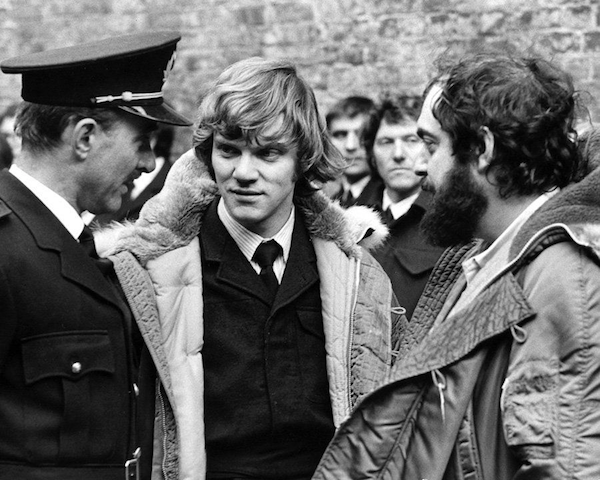Movie review by Greg Carlson
Abiding enthusiasm for continued discussion of the life and work of Stanley Kubrick manifests once again in feature-length documentary “A Forbidden Orange” (also known by its original Spanish title “La naranja prohibida”). Delving into the exhibition history of “A Clockwork Orange” in Spain, director Pedro González Bermúdez shines his flashlight into all kinds of nooks and crannies, but the movie – now available to watch in the United States via HBO Max – doesn’t measure up to several recent explorations of the master filmmaker’s singular career. Like many SK artifacts, Bermúdez’s movie will appeal most directly to those who already identify as rabid followers, cultists, and completists.
The complex story of the public reception to “A Clockwork Orange” has already been detailed in stacks of books, journal articles, biographies, and films. Like Paul Joyce’s 2000 Channel Four documentary “Still Tickin’: The Return of A Clockwork Orange” (included with the bonus features on the Warner Bros. 50th anniversary home media releases), the participation of lead actor Malcolm McDowell adds first-person star power to Bermúdez’s effort. McDowell alternates between scripted narration and personal recollections of his work with Kubrick, establishing a curious dual role.
Ostensibly, Bermúdez sets out to chronicle the programming of “A Clockwork Orange” at the 1975 Valladolid International Film Week festival via talking head interviews with many who participated, but the side trips are more tantalizing than the sights on the main highway. Scenes from Eloy de la Iglesia’s “Clockwork”-inspired, Sue Lyon-starring “Murder in a Blue World” (referred to here as “A Drop of Blood to Die Loving,” one of several different names attached to the movie) allude to a more dynamic and fascinating study of the immediate pop culture impact of “Clockwork.”
In the Cambridge Film Handbooks series on “A Clockwork Orange,” Kubrick scholar Robert Kolker writes, “Its apparent thesis that unfettered free will, expressed as violent disruption of other people’s lives, is better than repression and a loss of freedom seems undeniable. What’s more, its style and narrative structure keep the spectator in a position of awed conviction, distant and involved, amused and horrified, convinced and querulous, and at every moment involved.” Occasionally, Bermúdez latches on to this sentiment, elevating “A Forbidden Orange” beyond the memories of those involved with the Villadolid screening to critically address one of Kubrick’s most controversial creations.
The film’s anecdotes about bomb threats, ticket queues, university students, and the waning influence of the Franco regime over contemporary artist expression – the dictator died just seven days prior to the “Clockwork” screening – rhyme with other tales in which film and politics combust (like the May 1968 events in Paris following the dismissal of Henri Langlois from the Cinémathèque Française), but the most engaging sections of “A Forbidden Orange” return to Kubrick’s film and the way in which it affected viewers.
Near the end of the documentary, Bermúdez presents a series of portrait shots of younger subjects, the vast majority of whom have never seen “A Clockwork Orange.” Their fresh before-and-after responses remind veteran cinephiles that even the most durable and seemingly timeless objects could be more fragile than we think. As long as there are enthusiasts like Bermúdez, however, the posthumous Stanley Kubrick industry looks to continue for a long time.
